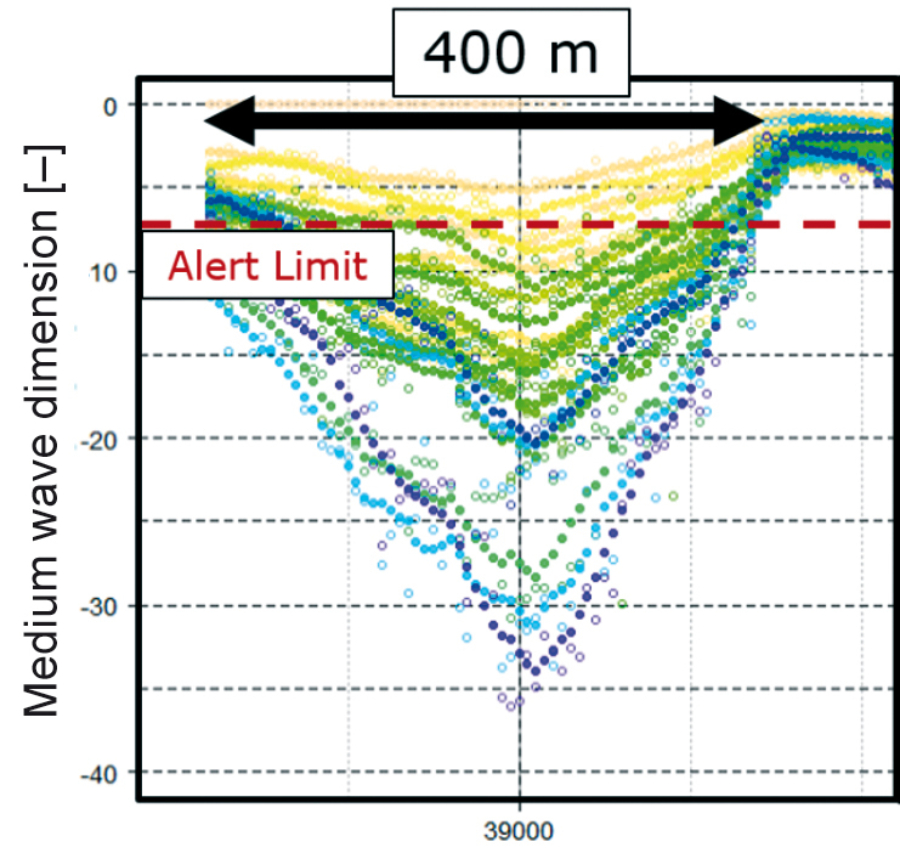
For carrying out a technical assessment, we recommend a holistic view or a combination of several analysis methods. A starting point in the decision-making process are track geometry errors. Measuring runs can flag up the necessity for ballast cleaning. A poor track geometry in the wavelenght range of 5-6 m indicates hollow spaces, which, in turn, suggest a poor ballast condition.
Another option for identifying critical points is the fractal analysis. It is considered the method for identifying patterns in patterns and can determine the specific roughness of signals by taking into consideration different wavelengths (long, medium or short waves, depending on the frequency range). Track geometry analyses, however, cannot determine the content of fines in the ballast bed or the moisture of the track bed, but only its reaction.

The Austrian Federal Railways performed fractal analyses on approx. 4,000 km of their mainline network. It was possible to utilise the measurement signals of the past 14 years in combination with detailed information on the infrastructure and maintenance operations. To validate this new method, the results of the fractal analysis were compared with a ground penetrating radar survey of approx. 1,000 line kilometres and many excavations.
The figure shows the development over time of the fractal medium wave within a 400 m section of track in Austria. Here the value is -34, which is four times higher than the 90% quantile of the network. An inspection on site confirmed the results of the fractal analysis. On the surface the ballast was run in visibly. The ballast under the sleeper was completely fouled and the maintenance history showed an unstable track geometry. Shortly after the inspection, the ballast bed was cleaned and the majority of the sleepers replaced. Today, Austrian Railways and Swiss Railways have been using fractal analyses as a part of their asset management.
Sources:
Landgraf, M.: “Zustandsbeschreibung des Fahrwegs der Eisenbahn – von der Messdatenanalyse zum Anlagenmanagement” (Railway Track Condition: Assessment – Aggregation – Asset Management), 2016 (Doctoral Thesis, Graz University of Technology)
Hansmann, F.: “Innovative Messdatenanalyse – ein Beitrag für ein nachhaltiges Anlagenmanagement Gleis” (Modern Asset Management Track based on the Analysis of Measurement Data), 2015 (Doctoral Thesis, Graz University of Technology)
Ballast bed fouling can also be diagnosed using ground penetrating radar applications (GPR). Due to its special signal characteristics it is possible to determine the degree of ballast fouling. The propagation of electro-magnetic waves in the subsoil depends to a large extent on the structures in the ground which cause the reflection, dispersion, flection and transmission of the radiated wave. Water strongly influences the GPR analysis. Therefore, it is easy to quantify the current moisture content in the track bed, to evaluate the current drainage quality and to determine the thickness of the different layers on the basis of their decreasing water content. Based on GPR examinations, different degrees of fouling can be calculated without the need for time-consuming excavations.
The direct assessment of the condition of the ballast in the ballast bed is another safe indicator for the need for ballast cleaning – however, it is very laborious. Visual inspections or the analysis of video recordings from measuring vehicles provide information about areas with visibly heavy fouling and large wet spots.
Currently, the degree of fouling and the fine grain content can only be measured reliably by taking samples and screening the material. The samples can be taken manually (frame test) or mechanically with a drilling device. There is no generally applicable limit value for making the decision as to when the ballast should be cleaned.
Depending on the country and the respective guidelines by the railway administrations or the infrastructure operators, different particle size distribution curves with different limit values are in place. Based on these particle size distribution curves, the grain sizes and proportion of fines differ from country to country. In Europe the limit value of 30% proportion of fines (<22.4 mm), as stated in the ERRI Report D182 (European Rail Research Institute), has become best practice. Once this point is reached it is high time for ballast bed cleaning or track renewal.
Maintaining a balance between the load-bearing capacity and drainage capacity of the ballast bed is key.
Knowledge of the technical necessity of ballast bed cleaning is an essential prerequisite for assessing its economic efficiency.